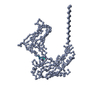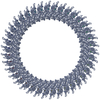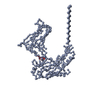[English] 日本語
 Yorodumi
Yorodumi- PDB-2bk1: The pore structure of pneumolysin, obtained by fitting the alpha ... -
+ Open data
Open data
- Basic information
Basic information
| Entry | Database: PDB / ID: 2bk1 | ||||||
|---|---|---|---|---|---|---|---|
| Title | The pore structure of pneumolysin, obtained by fitting the alpha carbon trace of perfringolysin O into a cryo-EM map | ||||||
 Components Components | PERFRINGOLYSIN O | ||||||
 Keywords Keywords |  TOXIN / TOXIN /  CYTOLYSIS / CYTOLYSIS /  HEMOLYSIS / HEMOLYSIS /  THIOL-ACTIVATED CYTOLYSIN / THIOL-ACTIVATED CYTOLYSIN /  CRYOEM / CRYOEM /  CYTOLYTIC PROTEIN CYTOLYTIC PROTEIN | ||||||
| Function / homology |  Function and homology information Function and homology information hemolysis in another organism / hemolysis in another organism /  cholesterol binding / cholesterol binding /  toxin activity / membrane => GO:0016020 / host cell plasma membrane / extracellular region / toxin activity / membrane => GO:0016020 / host cell plasma membrane / extracellular region /  membrane membraneSimilarity search - Function | ||||||
| Biological species |   CLOSTRIDIUM PERFRINGENS (bacteria) CLOSTRIDIUM PERFRINGENS (bacteria) | ||||||
| Method |  ELECTRON MICROSCOPY / ELECTRON MICROSCOPY /  single particle reconstruction / single particle reconstruction /  cryo EM / Resolution: 29 Å cryo EM / Resolution: 29 Å | ||||||
| Model type details | CA ATOMS ONLY, CHAIN A | ||||||
 Authors Authors | Tilley, S.J. / Orlova, E.V. / Gilbert, R.J.C. / Andrew, P.W. / Saibil, H.R. | ||||||
 Citation Citation |  Journal: Cell / Year: 2005 Journal: Cell / Year: 2005Title: Structural basis of pore formation by the bacterial toxin pneumolysin. Authors: Sarah J Tilley / Elena V Orlova / Robert J C Gilbert / Peter W Andrew / Helen R Saibil /  Abstract: The bacterial toxin pneumolysin is released as a soluble monomer that kills target cells by assembling into large oligomeric rings and forming pores in cholesterol-containing membranes. Using cryo-EM ...The bacterial toxin pneumolysin is released as a soluble monomer that kills target cells by assembling into large oligomeric rings and forming pores in cholesterol-containing membranes. Using cryo-EM and image processing, we have determined the structures of membrane-surface bound (prepore) and inserted-pore oligomer forms, providing a direct observation of the conformational transition into the pore form of a cholesterol-dependent cytolysin. In the pore structure, the domains of the monomer separate and double over into an arch, forming a wall sealing the bilayer around the pore. This transformation is accomplished by substantial refolding of two of the four protein domains along with deformation of the membrane. Extension of protein density into the bilayer supports earlier predictions that the protein inserts beta hairpins into the membrane. With an oligomer size of up to 44 subunits in the pore, this assembly creates a transmembrane channel 260 A in diameter lined by 176 beta strands. #1:  Journal: Cell / Year: 1997 Journal: Cell / Year: 1997Title: Structure of a cholesterol-binding, thiol-activated cytolysin and a model of its membrane form. Authors: J Rossjohn / S C Feil / W J McKinstry / R K Tweten / M W Parker /  Abstract: The mechanisms by which proteins gain entry into membranes is a fundamental problem in biology. Here, we present the first crystal structure of a thiol-activated cytolysin, perfringolysin O, a member ...The mechanisms by which proteins gain entry into membranes is a fundamental problem in biology. Here, we present the first crystal structure of a thiol-activated cytolysin, perfringolysin O, a member of a large family of toxins that kill eukaryotic cells by punching holes in their membranes. The molecule adopts an unusually elongated shape rich in beta sheet. We have used electron microscopy data to construct a detailed model of the membrane channel form of the toxin. The structures reveal a novel mechanism for membrane insertion. Surprisingly, the toxin receptor, cholesterol, appears to play multiple roles: targeting, promotion of oligomerization, triggering a membrane insertion competent form, and stabilizing the membrane pore. | ||||||
| History |
|
- Structure visualization
Structure visualization
| Movie |
 Movie viewer Movie viewer |
|---|---|
| Structure viewer | Molecule:  Molmil Molmil Jmol/JSmol Jmol/JSmol |
- Downloads & links
Downloads & links
- Download
Download
| PDBx/mmCIF format |  2bk1.cif.gz 2bk1.cif.gz | 26.3 KB | Display |  PDBx/mmCIF format PDBx/mmCIF format |
|---|---|---|---|---|
| PDB format |  pdb2bk1.ent.gz pdb2bk1.ent.gz | 14.5 KB | Display |  PDB format PDB format |
| PDBx/mmJSON format |  2bk1.json.gz 2bk1.json.gz | Tree view |  PDBx/mmJSON format PDBx/mmJSON format | |
| Others |  Other downloads Other downloads |
-Validation report
| Arichive directory |  https://data.pdbj.org/pub/pdb/validation_reports/bk/2bk1 https://data.pdbj.org/pub/pdb/validation_reports/bk/2bk1 ftp://data.pdbj.org/pub/pdb/validation_reports/bk/2bk1 ftp://data.pdbj.org/pub/pdb/validation_reports/bk/2bk1 | HTTPS FTP |
|---|
-Related structure data
| Related structure data |  1107MC  1108MC  1106C  2bk2C C: citing same article ( M: map data used to model this data |
|---|---|
| Similar structure data |
- Links
Links
- Assembly
Assembly
| Deposited unit | 
|
|---|---|
| 1 | x 38
|
| 2 |
|
| 3 | 
|
| Symmetry | Point symmetry: (Schoenflies symbol : C38 (38 fold cyclic : C38 (38 fold cyclic )) )) |
- Components
Components
| #1: Protein | Mass: 50095.902 Da / Num. of mol.: 1 / Fragment: RESIDUES 53-500 Source method: isolated from a genetically manipulated source Source: (gene. exp.)   CLOSTRIDIUM PERFRINGENS (bacteria) / Production host: CLOSTRIDIUM PERFRINGENS (bacteria) / Production host:   ESCHERICHIA COLI (E. coli) / References: UniProt: P19995, UniProt: P0C2E9*PLUS ESCHERICHIA COLI (E. coli) / References: UniProt: P19995, UniProt: P0C2E9*PLUS |
|---|
-Experimental details
-Experiment
| Experiment | Method:  ELECTRON MICROSCOPY ELECTRON MICROSCOPY |
|---|---|
| EM experiment | Aggregation state: PARTICLE / 3D reconstruction method:  single particle reconstruction single particle reconstruction |
- Sample preparation
Sample preparation
| Component | Name: PNEUMOLYSIN / Type: COMPLEX / Type: COMPLEXDetails: THE SAMPLE CONSISTS OF PNEUMOLYSIN IN A MEMBRANE-INSERTED PORE STATE |
|---|---|
| Buffer solution | Name: 8 MM NA2HP04, 1.5MM KH2PO4, 2.5 MM KCL, 0.25 MM NACL / pH: 6.95 Details: 8 MM NA2HP04, 1.5MM KH2PO4, 2.5 MM KCL, 0.25 MM NACL |
| Specimen | Conc.: 0.05 mg/ml / Embedding applied: NO / Shadowing applied: NO / Staining applied : NO / Vitrification applied : NO / Vitrification applied : YES : YES |
| Specimen support | Details: HOLEY CARBON |
Vitrification | Instrument: HOMEMADE PLUNGER / Cryogen name: ETHANE / Details: PLUNGED INTO ETHANE |
- Electron microscopy imaging
Electron microscopy imaging
| Experimental equipment |  Model: Tecnai F20 / Image courtesy: FEI Company |
|---|---|
| Microscopy | Model: FEI TECNAI F20 Details: SAMPLES WERE MAINTAINED AT LIQUID NITROGEN TEMPERATURES IN THE ELECTRON MICROSCOPE. |
| Electron gun | Electron source : :  FIELD EMISSION GUN / Accelerating voltage: 200 kV / Illumination mode: FLOOD BEAM FIELD EMISSION GUN / Accelerating voltage: 200 kV / Illumination mode: FLOOD BEAM |
| Electron lens | Mode: BRIGHT FIELD Bright-field microscopy / Nominal magnification: 42000 X / Nominal defocus max: 3200 nm / Nominal defocus min: 1100 nm / Cs Bright-field microscopy / Nominal magnification: 42000 X / Nominal defocus max: 3200 nm / Nominal defocus min: 1100 nm / Cs : 2 mm : 2 mm |
| Specimen holder | Temperature: 100 K / Tilt angle max: 0 ° / Tilt angle min: 0 ° |
| Image recording | Electron dose: 20 e/Å2 / Film or detector model: KODAK SO-163 FILM |
| Image scans | Num. digital images: 135 |
| Radiation wavelength | Relative weight: 1 |
- Processing
Processing
CTF correction | Details: PHASE FLIPPING | ||||||||||||
|---|---|---|---|---|---|---|---|---|---|---|---|---|---|
| Symmetry | Point symmetry : C38 (38 fold cyclic : C38 (38 fold cyclic ) ) | ||||||||||||
3D reconstruction | Resolution: 29 Å / Num. of particles: 88 / Nominal pixel size: 3.5 Å Details: RESIDUES 134-142 ARE MISSING FROM THE SEQUENCE. RESIDUES CORRESPONDING TO TO TM1 AND TM2 (187-220,284-315) WERE MODELLED AS A POLY-ALANINE FLAT BETA HAIRPINS. THE OLIGOMER CAN BE GENERATED ...Details: RESIDUES 134-142 ARE MISSING FROM THE SEQUENCE. RESIDUES CORRESPONDING TO TO TM1 AND TM2 (187-220,284-315) WERE MODELLED AS A POLY-ALANINE FLAT BETA HAIRPINS. THE OLIGOMER CAN BE GENERATED BY APPLYING 38-FOLD ROTATIONAL SYMMETRY. Symmetry type: POINT | ||||||||||||
| Atomic model building | Protocol: RIGID BODY FIT Details: METHOD--THE CRYSTAL STRUCTURE OF PERFRINOGLYSIN O (1PFO, ROSSJOHN ET AL., 1998, CELL 89, 685)WAS PLACED INTO THE CRYO-EM DENSITY MAP (EMD-1107). THE ALPHA CARBON TRACE OF PERFRINGOLYSIN 0 ...Details: METHOD--THE CRYSTAL STRUCTURE OF PERFRINOGLYSIN O (1PFO, ROSSJOHN ET AL., 1998, CELL 89, 685)WAS PLACED INTO THE CRYO-EM DENSITY MAP (EMD-1107). THE ALPHA CARBON TRACE OF PERFRINGOLYSIN 0 WAS MANUALLY POSITIONED INTO THE CRYO-EM DENSITY CORRESPONDING TO THE POSITION OF ONE SUBUNIT. THE BEST FIT WAS OBTAINED BY SEPARATING THE MONOMER INTO SIX RIGID BODIES- DOMAIN 1(91-172, 231-272 354-373), DOMAIN 2 UPPER (53- 62, 83-90, 374-381), DOMAIN 2 LOWER (63-82, 382-390), DOMAIN 3 (177-186, 221-230, 273-283, 316-353), DOMAIN 3 HAIRPINS (187- 220, 284-315), AND DOMAIN 4 (391-500). THE COMPLETE OLIGOMER (38-MER) WAS GENERATED AND CHECKED FOR CLOSE CONTACTS BOTH BY EYE AND USING THE CCP4 PROGRAM CONTACT.TO IMPROVE THE FIT SECTIONS CORRESPONDING TO 3 SUBUNITS WERE EXTRACTED FROM THE 38-MER MAP (EMD-1107) AND A 44-MER MAP AND ALIGNED. THE WEIGHTED AVERAGE WAS CALCULATED AND THE IMPROVED MAP USED FOR THE FINAL MANUAL FITTING. THE TWO SECTIONS ARE CONSISTENT TO A RESOLUTION OF 28 ANGSTROMS (0.5 CORRELATION FSC) AND THE WEIGHTED AVERAGE MAP WAS RECONSTRUCTED FROM 131 PARTICLES. | ||||||||||||
| Atomic model building | PDB-ID: 1PFO | ||||||||||||
| Refinement | Highest resolution: 29 Å | ||||||||||||
| Refinement step | Cycle: LAST / Highest resolution: 29 Å
|
 Movie
Movie Controller
Controller






 PDBj
PDBj